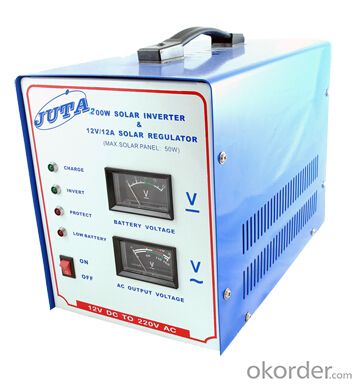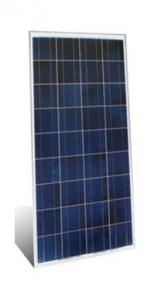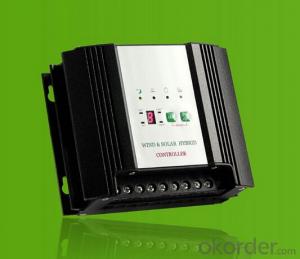200W Solar Inverter with Built-in Controller
- Loading Port:
- Shanghai
- Payment Terms:
- TT OR LC
- Min Order Qty:
- 10 unit
- Supply Capability:
- 50 unit/month
OKorder Service Pledge
OKorder Financial Service
You Might Also Like
1. Structure of 200W Solar Inverter with Built-in Controller
This Inverter with Built in Controller could uninterruptible charge the battery at day time with solar panel, adjust the charge current according to the voltage of battery to prolong life time of battery, float charging which could make battery always to be fully state for urgent power supply. Besides this product also have reverse current protection from battery to solar panel.
2. Main Features of 200W Solar Inverter with Built-in Controller
Battery Low Voltage Protection
DC Input Overvoltage Protection.
Overload Protection
Short Circuit Protection
Thermal Protection
Fault Indication Function
3. 200W Solar Inverter with Built-in Controller Images

4. 200W Solar Inverter with Built-in Controller Specification
Max. current for solar power charging | 12A |
Max. USB output current | 600mA |
Max. DC socket output current | 2A |
Input voltage | DC10—14V |
Output power | ≤200W |
Input current | 0.5—25A |
No-load loss | ≤1.5% |
Output wave shape | Modified |
Output voltage | AC 205—230V |
Accumulator charging off voltage | 14V |
Accumulator supply off voltage | 10.2V |
Accumulator supply recovery voltage | 12.6V |
Output frequency | 50—60HZ |
5. FAQ
We have organized several common questions for our clients, which may help you sincerely:
1 ) How to guarantee the quality of the products?
The company presses the ISO9000 quality management system control product quantity strictly, the export production all passes the relevant national company check (CE, ROHS), and get high evaluation of the customer.
2 ) How long can we receive the product after signing Sales Confirmation?
Generally speaking, if there is enough quantity of finished products which can meet the clients’ requirement, we can manage the delivery within three to five working days according to the instruction of the payment terms in the Sales Confirmation; if the products need some time to get ready, we will arrange thedelivery as soon as possible after the manufacture.
- Q:How does a solar controller handle the protection against lightning strikes?
- A solar controller typically does not provide direct protection against lightning strikes. However, it may have surge protection devices or overvoltage protection mechanisms built-in to safeguard the solar panels and other connected equipment from potential damage caused by lightning-induced power surges. It is recommended to install additional lightning protection measures, such as lightning rods or surge protectors, to ensure comprehensive protection against lightning strikes in a solar power system.
- Q:What is the maximum output current for a solar controller?
- The maximum output current for a solar controller is determined by its specifications and can vary depending on the model and design. It is typically mentioned in the product's documentation or labeling, and can range from a few amperes to several tens of amperes.
- Q:Can a solar controller be used with solar panel arrays in parallel?
- Yes, a solar controller can be used with solar panel arrays in parallel. A solar controller is designed to regulate and optimize the charging of batteries in a solar power system, regardless of the configuration of the solar panels. Whether the panels are connected in series or parallel, the solar controller will ensure that the batteries receive the appropriate charging voltage and current to maximize their efficiency and lifespan.
- Q:How does a solar controller prevent damage from reverse polarity connections?
- A solar controller prevents damage from reverse polarity connections by utilizing built-in protection mechanisms that detect and block the flow of current when the positive and negative terminals are incorrectly connected. This prevents any potential damage to the solar panels, batteries, or other connected devices, ensuring the system remains safe and functional.
- Q:Can a solar controller be used with solar panel sun tracking systems?
- Yes, a solar controller can be used with solar panel sun tracking systems. A solar controller is designed to regulate the voltage and current from the solar panels to ensure proper charging of batteries or powering of electrical devices. It monitors the input from the solar panels and adjusts the output accordingly to maximize efficiency and protect the system from overcharging or overloading. In the case of solar panel sun tracking systems, the solar controller plays a crucial role in managing the power generated by the panels. Sun tracking systems use sensors and motors to adjust the position of the solar panels throughout the day, ensuring they are always facing the sun for maximum sunlight exposure. This means that the output voltage and current from the panels can vary depending on their positioning. The solar controller will take into account these variations and optimize the charging or power supply accordingly. It will continually monitor the input from the solar panels, adjust the charging parameters, and regulate the output to ensure the batteries are charged properly or the electrical devices are powered efficiently. Using a solar controller with solar panel sun tracking systems is highly recommended as it helps to maintain the overall performance and longevity of the system. It ensures that the solar panels are working at their maximum potential, maximizing the energy output and increasing the overall efficiency of the system.
- Q:What are the advantages of using a PWM solar controller?
- There are several advantages of using a PWM (Pulse Width Modulation) solar controller. Firstly, PWM controllers are cost-effective and readily available in the market. They are simpler in design, making them less expensive compared to MPPT (Maximum Power Point Tracking) controllers. Secondly, PWM controllers are highly efficient in charging batteries. They can effectively regulate and control the charging process, preventing overcharging and extending the lifespan of the batteries. Additionally, PWM controllers are suitable for smaller solar power systems or applications where the solar panel voltage matches the battery voltage. They work well in situations where the solar panel array is not oversized or if the system operates at a high voltage. Furthermore, PWM controllers are easy to install and operate, making them a user-friendly option for individuals or businesses new to solar energy systems. They require minimal maintenance and typically have built-in protection features against overvoltage, overload, and short circuits. In summary, the advantages of using a PWM solar controller include cost-effectiveness, high charging efficiency, compatibility with smaller systems, ease of installation and operation, and built-in protection features.
- Q:Can a solar controller be used with different types of solar panel fault detection systems?
- Yes, a solar controller can be used with different types of solar panel fault detection systems. The solar controller acts as the central hub for monitoring and managing the solar panel system, regardless of the specific fault detection system being used. It is designed to integrate with various types of fault detection systems, ensuring compatibility and efficient operation of the entire solar power system.
- Q:How does a solar controller prevent damage to the solar panels from birds or animals?
- A solar controller does not directly prevent damage to solar panels from birds or animals. However, there are additional measures that can be taken to mitigate the risk of damage caused by birds or animals. One common method is to install bird deterrents or protective measures around the solar panels. These can include bird netting, spikes, or wires placed strategically to discourage birds from landing or nesting on the panels. Another approach is to create a physical barrier around the solar panels using fencing or mesh. This prevents larger animals from accessing the panels and potentially causing damage. Additionally, some solar panel installations may incorporate motion-activated devices or ultrasonic deterrents that emit sounds or vibrations to scare away birds or animals. These devices can provide a level of protection by deterring unwanted visitors. It's important to note that a solar controller primarily regulates the flow of electricity between the solar panels and the battery or grid. Its main function is to prevent overcharging or over-discharging of batteries, optimizing the charging process, and protecting the overall system. While a solar controller does not directly prevent damage from birds or animals, implementing the above-mentioned measures alongside a solar controller can help safeguard the panels from potential harm.
- Q:Can a solar controller be used with solar-powered electric vehicle chargers?
- Solar-powered electric vehicle chargers can indeed utilize a solar controller. Acting as a regulating device, a solar controller manages the electricity flow from solar panels to charging systems or batteries. Its primary objective is to ensure the charging efficiency remains high while safeguarding the battery against detrimental overcharging or any potential damage. Specifically concerning solar-powered electric vehicle chargers, a solar controller serves to govern the charging procedure and optimize the utilization of solar energy. It achieves this by controlling the charging speed and preserving the battery's overall health. With the aid of a solar controller, the charging system effectively harnesses solar power, providing a dependable and sustainable solution for electric vehicle charging.
- Q:Can a solar controller handle power fluctuations from the generator?
- Yes, a solar controller is designed to handle power fluctuations from the generator by regulating and stabilizing the incoming power from the generator before it is distributed to the solar panels or batteries.
1. Manufacturer Overview |
|
|---|---|
| Location | |
| Year Established | |
| Annual Output Value | |
| Main Markets | |
| Company Certifications | |
2. Manufacturer Certificates |
|
|---|---|
| a) Certification Name | |
| Range | |
| Reference | |
| Validity Period | |
3. Manufacturer Capability |
|
|---|---|
| a)Trade Capacity | |
| Nearest Port | |
| Export Percentage | |
| No.of Employees in Trade Department | |
| Language Spoken: | |
| b)Factory Information | |
| Factory Size: | |
| No. of Production Lines | |
| Contract Manufacturing | |
| Product Price Range | |
Send your message to us
200W Solar Inverter with Built-in Controller
- Loading Port:
- Shanghai
- Payment Terms:
- TT OR LC
- Min Order Qty:
- 10 unit
- Supply Capability:
- 50 unit/month
OKorder Service Pledge
OKorder Financial Service
Similar products
New products
Hot products
Hot Searches
Related keywords





























